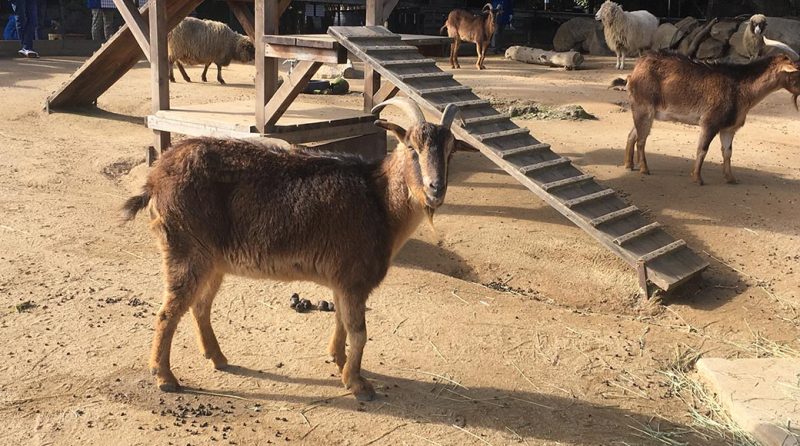
Michelle O’Malley studies the anaerobic gut fungi that allow many herbivores to turn grass into energy. Enzymes from these fungi might one day make fuel and chemical production more sustainable.
UC Santa Barbara
- More than 2 years ago
If you’ve visited the Santa Barbara Zoo, you may have seen members of Michelle O’Malley’s research team. They’re the folks in lab coats and gloves, hanging out with the San Clemente Island goats and the Navajo-Churro sheep, awaiting specimens that could radically change the source of the world’s fuels and chemicals.
“It can be hard to tell the difference between goat and sheep poop,” says O’Malley, 37, a chemical and biological engineer at the University of California, Santa Barbara. It helps to “watch the donation take place.” Once collected, the pellets go to the lab, where team members coax out the microorganisms that enable these animals to digest certain plants.
Specifically, O’Malley is after the anaerobic fungi that live in the digestive tract of herbivores such as sheep, goats, cows, giraffes and elephants. Along with some anaerobic bacteria, these fungi can break down grass and other plants, releasing sugars and nutrients for the animals. These particular microbial helpers are not typically members of the human digestive tract; the indigestible parts of plants pass through our guts as fiber.
O’Malley had to learn what she calls “very old-school technology” to grow the finicky fungi. Then she turned to investigating the distinctive plant-degrading enzymes the fungi make. Her big-picture plan is to sweep aside nonrenewable petroleum and pursue a more sustainable route to chemical and energy production that starts with agricultural leftovers —corn stover and wheat straw, for example — and other inedible plant material.

“As we’ve really delved into the discovery of these anaerobic fungi,” O’Malley says, “we’ve certainly found enzymes that could be transferred into industry that could be really good at breaking down cellulose, hemicellulose and even lignin” — the components of lignocellulose, the fibrous parts of plants.
Lignocellulose has loads of carbon, the base of fuels and backbone of many drugs and other chemicals. The problem is that lignin, which serves “to keep microbes and their enzymes out” of plant cell walls, O’Malley says, makes it difficult to get to the sugars cellulose and hemicellulose, which contain the carbon. For industrial uses, the lignin is chemically or physically removed — a process that is often costly, toxic and wasteful, as lignin itself contains valuable chemical components.
Some fungi have a better approach. After a goat’s grassy lunch, anaerobic fungi called Neocallimastigomycota burrow into the plant cell walls and release enzymes that break down lignocellulose — lignin and all. That O’Malley took on these challenging anaerobic fungi doesn’t surprise her graduate school adviser, chemical engineer Anne Robinson of Carnegie Mellon University in Pittsburgh. Robinson remembers her former student as “very unafraid to tackle problems” and the type of researcher who “is able to recognize the interesting or unusual result.”
Sign up for our newsletter
We summarize the week's scientific breakthroughs every Thursday.
After graduate school, O’Malley contacted scientists who had published research on anaerobic fungi. Most had abandoned the study of the difficult microbes. The only one who responded with an invitation to work together was Michael Theodorou, who pioneered research on the fungi and is now at Harper Adams University in Newport, England. At the time, Theodorou was in Wales, where he taught O’Malley how to isolate and grow the microbes.
It’s challenging to meet the fungi’s nutrient needs and keep oxygen out. The team begins with roll tubes, which are like 3-D petri dishes that offer an anaerobic environment. Carbon dioxide and a growth medium with digestive fluids are added to closed tubes. Next, the team rolls the tubes to get an even coat. Then comes a fungi-containing poop slurry, and the tubes are rolled again. If the process works, fungal colonies grow. “All of this requires a lot of careful, coordinated, quick movements,” O’Malley says. It’s “a lost art.”
Chomp chomp
Fungi in herbivore guts have a wealth of enzymes for breaking down biomass.
472
Total number of biomass-degrading enzymes in anaerobic fungus Neocallimastix californiae
158
Total number in Aspergillus nidulans, a common industry source of biomass-degrading enzymes
Source: K.V. Solomon et al/Science 2016
In her UC Santa Barbara lab, O’Malley has been isolating the anaerobic fungi from zoo samples and studying their enzymes. “Nobody really knew their true power,” she says. Neocallimastigomycota, it turns out, have genetic instructions for the largest number of biomass-degrading enzymes known in nature, she and her colleagues reported in Science in 2016.
The researchers have also partnered the anaerobic fungi with brewers’ yeast (Saccharomyces cerevisiae), a mainstay of the biochemical industry, in a two-step process. The fungi efficiently broke down lignocellulose in reed canary grass, freeing the sugars to be converted to other products by the yeast, O’Malley and colleagues reported in Biotechnology and Bioengineering in 2018.
With an eye toward unleashing these powers for the biotechnology industry, O’Malley and her group are exploring whether it makes sense to harvest the enzymes from the fungi themselves or to incorporate the fungal DNA into yeast or bacteria, turning these easy-to-work-with microbes into enzyme-making machines.
Figuring out the ideal method to degrade lignocellulose biomass “has been a really intractable problem for a long time,” says biochemical engineer Michael Betenbaugh of Johns Hopkins University. O’Malley “kind of forged out on her own by looking for these unusual microbes that have been doing [it] for millennia.”







